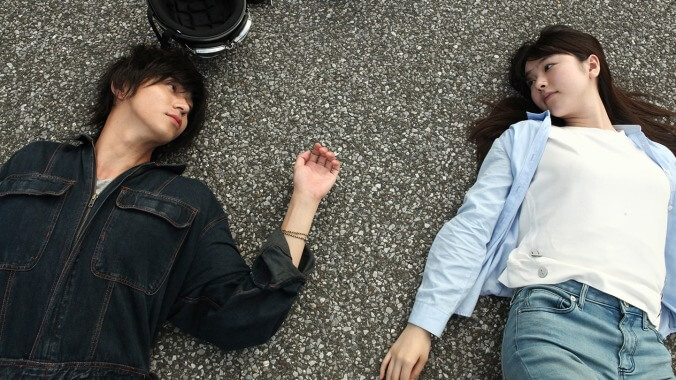When we first see Asako (Erika Karata), the central character of Ryûsuke Hamaguchi’s Asako I & II, she’s milling about a photography exhibition titled Self And Others—though it’s not long before her attention wanders to a slouchy hunk whose name, she later learns, is Baku (Masahiro Higashide). He exits the gallery; she follows close behind. When they eventually come face to face on a nearby waterfront, the film’s synth score crescendos and literal sparks fly, courtesy of some unruly kids setting off firecrackers all around them. When the pair finally kiss, a stray cherry bomb goes off. It’s the kind of clichéd touch that, like the entire sequence, is completely irresistible nonetheless, which makes for a fitting start to one of the most beguiling romances of recent years. This is a film that, through its deceptively mellow means, manages to plumb the depths of what it truly means to love amid the uncertainties of self, others, and everything else besides.
Hamaguchi, the film’s writer-director, first broke out in 2015 with Happy Hour, a five-and-a-half-hour, four-woman melodrama that at times plays like an Ozu film slowed down to real time. In this regard, Asako might seem like something of a departure, a shift from accomplished naturalism to high-concept genre: Adapted from Tomoka Shibasaki’s novel Netemo Sametemo (which roughly translates to “when asleep or awake”), the film extends the rich tradition of the cinematic double, the most famous instance of which remains Alfred Hitchcock’s Vertigo (1958). Despite the protests of her best friend, Haruyo—“good-looking, sure, but he’s bad news,” goes her frank assessment of Baku— Asako gets together with the mop-haired charmer, whose casual aloofness, DJing skills, and perfectly disheveled look prove too much to resist. And of course, there’s nothing quite like a swooning motorcycle ride, a near-death accident, and a blissful kiss on the hot pavement to jump-start a relationship. But just as suddenly as Baku comes into Asako’s life, he disappears. She will never see him again—or so she thinks, until two years later when she moves from Osaka to Tokyo and comes face to face with a sake salesman named Ryôhei (also played by Higashide). And wouldn’t you know it, he looks just like Baku, though with better posture, a more sensible haircut, and a stable job—the polar opposite of Baku’s bad-boy persona. Is this some long, elaborate con?
Not at all, as Asako quickly determines that Ryôhei is, in fact, a separate person from Baku. Yet throughout her courtship with the former—entered into more tentatively than before—the latter never seems far from her mind, and it’s this awareness that drives the rest of the film. In reality, Asako owes very little to Hitchcockian thrillers, and considerably more—in structure, if not much in tone—to the “remarriage comedies” of 1930s and ’40s Hollywood such as The Awful Truth and His Girl Friday. (The designation, coined by film scholar Stanley Cavell, would come later, though the template has since been taken up by directors as distinct as Eric Rohmer, whom Hamaguchi has cited as an influence, and Kiyoshi Kurosawa, his former professor at the Tokyo University of the Arts.) Even that description, though, risks intellectualizing a film that requires no such effort to enjoy. Make no mistake: Asako I & II, whose title seems to suggest a self-contained manga adaptation, is unabashedly, gloriously pop, filled with plot turns that would be right at home in an urban TV melodrama.
That characterization might seem like a backhanded compliment, and maybe it would be if Hamaguchi weren’t so adept at controlling the tenor of each moment, often destabilizing the story so it feels genuinely unsettled and unpredictable. (One major change Hamaguchi made from the novel was to transpose the timeline to include the 2011 Tōhoku earthquake.) In retrospect, the early romance with Baku plays as little more than a prologue for the second chapter, where, in keeping with the film’s title, there are doublings aplenty: another photography exhibition of Self And Others, another pair of friends, and another brush with death. It’s not difficult to intuit that Baku will somehow return, forcing Asako to choose between the two Higashides. But the particulars of this journey—best left for discovery—are as surprising and pleasurable as one is likely to see in any picture all year.
Part of this success has to do with Karata’s remarkably internalized performance as Asako, whose opacity creates in the film the aspect of a ghost story, a reminder of disaster lurking beneath every placid surface. She remains a mystery to the viewer—which is clearly by design, as much of Asako’s power resides in its insights regarding the vagaries of identity: the aspirational nature of tastes; the ways we, unwittingly or not, use pop clichés to craft our own narratives; and the ways that these in turn affect our relationships with others. (It’s no accident that Ryôhei works in marketing, or that one of the film’s biggest reveals comes with a sight gag of a giant billboard.) In other words, underneath all the genre doublings and dramatic reversals is an at times heartbreaking story about the rifts between the internal and external: the difficulties of keeping in sync with even ourselves, let alone the ones we love. It is this that Asako seems to ponder as, toward the end of the film, she stares out to sea. To struggle for such reconciliations of self and others may be nigh-impossible, but as Asako I & II affirms in its unique, incisive manner, this is, perhaps, the only defense we have against the ceaseless flow of time and tide.


